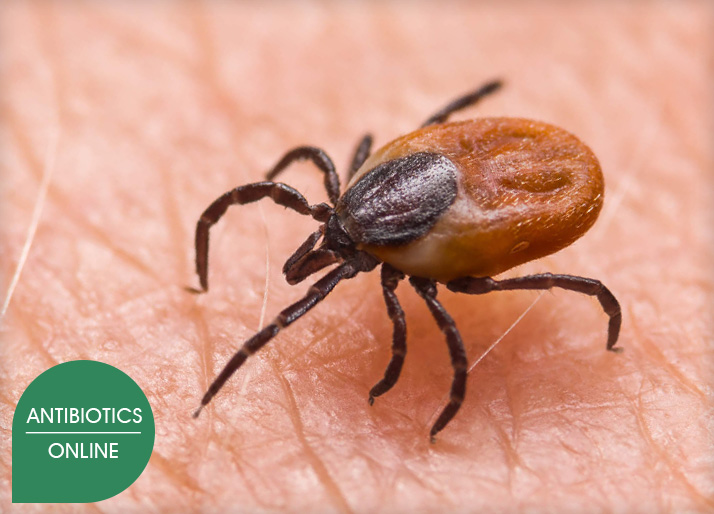Lyme borreliosis
Lyme disease, or Lyme borreliosis, is a tick-borne illness and the most prevalent vector-borne disease in the northern hemisphere. Its incidence is increasing globally, driven by demographic shifts and environmental changes, such as climate change.

What are the causes?
Lyme disease is transmitted by ticks, haematophagous (blood-feeding) arthropods belonging to the order Ixodida (family Ixodidae). The agent responsible for Lyme disease was isolated for the first time from a tick of the genus Ixodes in 1982 by Willy Burgdorfer, hence its name: Borrelia burgdorferi. It is a Gram-negative bacterium (genus Borrelia, family Spirochaetaceae). Many other species of Borrelia can be transmitted by ticks.
How is the bacterium transmitted?
In Europe, Borrelia burgdorferi is transmitted by the tick species Ixodes ricinus, which is widespread outside the Mediterranean and high altitude regions. It is a hard tick that can be found in different types of environment (forest, wooded pastures, garden) with micro-climatic conditions that are compatible with its survival and favourable to the frequentation of its hosts. The life cycle of the Ixodes tick is characterised by 3 evolutionary stages:
- The first two stages, larvae and nymphs, are asexual. Each of these stages is punctuated by a single blood meal on a vertebrate host, allowing passage to the next stage. During the third stage of evolution, which is sexual, the females gorge themselves, lay eggs and then die. The host range is broad and includes birds, rodents and deer. The larval stage is not considered capable of transmitting the disease. However, larvae are capable of acquiring the bacterium from their first blood meal on a host that is a reservoir for the bacterium (rodents and birds).
- It is during the second blood meal, when the nymph becomes an adult, that the bacteria already present in the nymph's digestive system pass through the intestinal barrier. It reaches the salivary glands and is transmitted to the host on which the tick is gorging itself with blood. Nymphs represent a high risk of transmitting the bacterium if they are infected because, due to their small size, they go unnoticed on the body and can be mistaken for moles.
Lyme disease is not transmitted between humans.
What are the symptoms?
The disease progresses through three phases: primary, secondary and tertiary.
The primary phase is characterised by a painless red patch around the bite, spreading rapidly and measuring 5 cm or more in size at the point of inoculation. This is known as erythema migrans. This is the most common manifestation (around 80% of cases). If the disease is not treated at this early stage, neurological, joint, cardiac or skin complications may occur during the secondary and tertiary phases of the disease.
The secondary phase begins a few weeks after the rash appears. However, its clinical expression varies greatly from patient to patient. It may manifest as multiple migrant erythemas, neurological manifestations or, more rarely, joint, skin, cardiac or ophthalmological symptoms.
The tertiary phase is a late disseminated phase and corresponds to a chronic course of the disease. At this stage, the disease mainly manifests itself in the joints, skin or nerves.
Although the disease is not fatal, if left untreated, it can leave disabling after-effects.
How is the disease diagnosed?
Erythema migrans is a diagnostic marker and no additional laboratory tests are necessary.
Diagnosis depends on clinical assessment and is supported by laboratory tests in the secondary and tertiary phases of borreliosis. An enzyme-linked immunosorbent assay (ELISA) is generally prescribed to detect antibodies to the bacteria, and should be followed by further tests if positive.
What treatments are available?
At present, the only means of treating borreliosis are antibiotics, which are rapidly effective if the diagnosis is made early enough. Antibiotic doses depend on the patient's age, medical history, allergies and state of health.
There is no vaccine against Lyme disease.
How can the disease be prevented?
The most effective preventive measures are to wear long, light-coloured clothing that makes it easier to spot ticks during outdoor activities, to use repellents (beware of any contraindications), to avoid areas where ticks are known to be present (wooded areas, tall grass, etc.) and to carry out scrupulous inspections when returning from walks. In the event of a bite, it is essential to remove the tick quickly using a tick remover, as the risk of infection by the bacteria is greater if the tick remains attached for a long time. Increased surveillance should also be carried out for 4 to 8 weeks.
How many people are affected?
Lyme borreliosis affects the northern hemisphere (North America, Europe and Asia).
In Europe, it is only possible to make an approximate estimate of the incidence of Lyme borreliosis, as it is not a notifiable disease in most countries.
In UK, between 2009 and 2024, the estimated number of annual cases has varied between 2,6146 and 6,8530, with an upward trend.
The risk of infection depends on the geographical area, ecological factors and the increase in outdoor human activities. The number of human cases of Lyme borreliosis fluctuates throughout the year, and is highest from spring to autumn, correlating well with the tick's life cycle.
The speed of transmission by infected ticks
Researchers at the Institut Pasteur have studied the transmission of bacteria in mice by ticks infected with different species of European and North American Borrelia. Bacteria appear to be transmitted very rapidly when bitten, with infection occurring in the first 24 hours following the bite of an adult tick, and sometimes even faster in the case of nymphs. This is a good opportunity to reiterate the need to remove ticks as soon as possible after the bite to prevent infection.
Lyme borreliosis is the most common vector-borne disease in Europe. It is caused by spirochetes belonging to the Borrelia burgdorferi complex, in the broadest sense. This complex includes several species that are pathogenic to humans: Borrelia burgdorferi sensu stricto, B. afzelii, B. garinii, B. bavariensis, B. spielmanii, B. valaisiana and B. lusitaniae. The bacteria are transmitted by the bite of a hard tick of the genus Ixodes. In Europe, it is mainly transmitted by Ixodes ricinus ticks. Ticks can parasitise a wide range of hosts. Humans are considered to be accidental hosts, and transmission can occur when they come into contact with an environment suitable for ticks.
There are several developmental stages of the tick (larva, nymph and adult) that can bite humans. However, bacteria are more likely to be transmitted by bites from nymphs, which are more densely populated and, because of their small size, are more likely to go unnoticed.
The time taken for the tick to attach itself and transmit the bacteria to the vertebrate host is an essential parameter when considering the risk of transmission and measures to prevent infection. It is generally stated that the risk of transmission increases with the duration of tick attachment. In Europe, it is regularly stated that the risk of transmission is real after 24 hours of attachment.
In this study, we set out to define the kinetics of infection by Ixodes ricinus ticks (nymphs and adult females) infected with different strains or species of Borrelia (European and North American), in a murine model. We also compared the spread of different strains and species of Borrelia by different methods of inoculation (via infected ticks or by injection of bacteria).
In contrast to the American strains, all the European B. burgdorferi species we studied were detected in the salivary glands of adult ticks before the blood meal, suggesting the possibility of rapid transmission of the bacteria when bitten. In good agreement, infection occurs within the first 24 hours following the bite of the adult tick. Furthermore, our analysis shows that nymphs infected with European species of B. burgdorferi are capable of transmitting these pathogens within 12 hours of tick attachment. Our study proves that transmission of B. burgdorferi can occur more rapidly than specified in the literature. It is therefore necessary to remove the ticks as soon as possible after the bite in order to prevent infection.
In addition, our study shows that Borrelia tropism varies according to the strain and species studied, explaining the variety of clinical manifestations of Lyme borreliosis. We also show a difference in Borrelia tropism after tick bites, confirming the role of tick saliva in the efficiency of infection and dissemination in vertebrate hosts.

